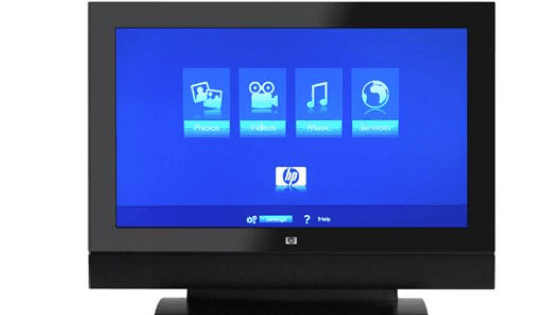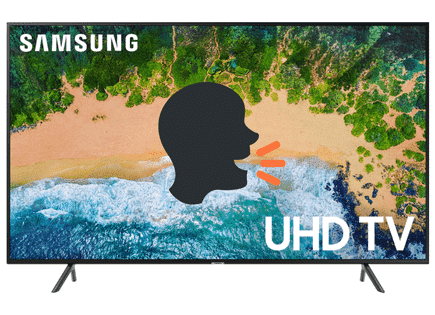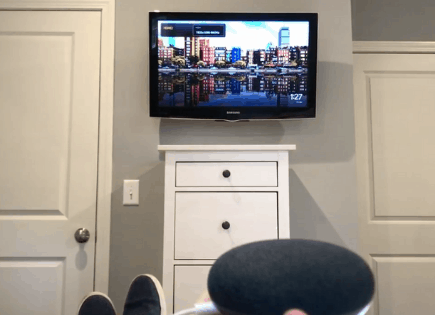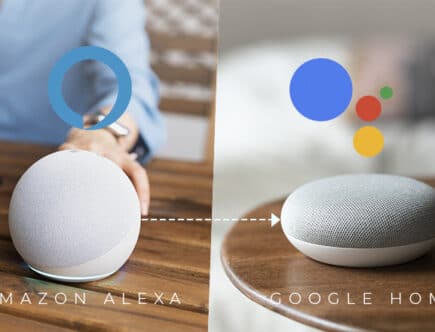
What Year Did the Smart TV Come Out? (the FULL Story)
Though there had been earlier innovations, the first ever patent for a Smart TV was granted in 1994 to a French firm called Fast France Advanced Systems. But it wasn’t until 2007 when the first Smart TV, HP’s MediaSmart TV (SL3760), was actually developed.
The evolution story of your great grandma’s 80-pound cathode ray tube TV from the 1920s to the ultra-light, incredibly thin, and insanely capable smart TVs of today, is an extraordinary one.
Your Grandma’s cathode ray tube TV
Back in the day, a TV or television set was a device that incorporated the use of a tuner, a monitor, and speakers – all for the sole purpose of viewing and hearing broadcasts from satellites or cables.
This simple mechanical device was introduced in the late 1920s. It used a technology called CRT (or cathode ray tube), and an outdoor antenna to capture broadcasts from nearby TV stations.

In the 1960s, the TV’s popularity increased dramatically with the addition of color to broadcast television. Then, in the 70s, it was further used as a display device for recorded media, such as Betamax, VHS, and DVDs.
The use of the TV was greatly enhanced again in the 1980s when the first generation of video games and home computers became popular and the TV was used as an alternative display device.
By the early 2010s, Liquid Crystal Display (LCD) technology finally became affordable and took off, resulting in a near-total takeover of the television market at the time. They were sleeker, lighter, and had more capabilities than the old cathodes.
With the Internet’s dramatic rise in popularity in the 2000s, TV manufacturers knew technological innovation was coming to their industry, and they all wanted to be first.
Due to the endless possibilities that the internet provided, everything was being made “smart” – from the smallest of cell phones to the largest of TVs.
What makes a Smart TV, smart?
A Smart TV is a combination of a computer and a regular TV, with integrated internet (WiFi) and web features. Its functions include viewing content from different sources (apps), browsing the internet, streaming videos and music, and a whole lot more.
Smart TVs’ integrated internet, advanced computing capabilities, and connectivity give the user the flexibility and the dynamism of utilizing the power of the internet, all from their TV.
As such, these TVs allow the user to run applications that were downloaded from desired sites or platforms and take full advantage of being connected to just about anything on the internet.
This opens up a wide range of entertainment options – from video streaming services like Netflix and Hulu to engagement on social media, playing games, and even controlling a whole household of interconnected gadgets and devices.
A Smart TV is a technological advancement converging TVs, computers, and set-top boxes (a device formerly used to convert video content to digital for analog TV).
Third-party developers use the public Software Development Kit (SDK) and/or Native Development Kit (NDK) within the Smart TV’s operating system, to develop apps which are then made available to the users through an app store.
Once the Smart TV is connected to the internet, the end user is able to install and uninstall desired apps themself. They can enjoy their Smart TVs as much as they would their mobile phones, tablets, laptops, or PCs.

Through continuous innovation, a large number of Smart TV models now have voice recognition capabilities, allowing the user to easily switch channels, search programs, navigate across an integrated smart home device to switch on/off lights, open/lock doors, and much more.
Even with all the great functionality that a Smart TV offers, the technology is ever-evolving, with the availability of proprietary, as well as, open-source frameworks.
These frameworks can run applications, play media services, personalize communications, and provide access to social networking features.
The evolution of the Smart TV
Prior to recent developments, back in the early 1980s, there was what they called an “intelligent television receiver” that was introduced in Japan.
A character generator and an LSI chip with memory were added to the television, which enabled Japanese viewers to receive information transmitted through the broadcast television signals.
Japan’s intelligent TV systems were linked to data networks by data processing systems, giving them the ability to download software routines.
Though there had been earlier innovations, the first ever patent for a Smart TV was granted in 1994 to a French firm, but it was not until 2007 when the first Smart TV, HP’s MediaSmart TV (SL3760), was developed.
This model was a high-definition LCD TV that offered wired or wireless streaming of audio and video files from the PC to the TV.
Then in 2008, Samsung developed the PAVV Bordeaux TV 750.
Samsung’s revolutionary Smart TV was full HD and had 1GB of built-in memory for a preloaded library, games, and browsing abilities.
By connecting the TV via a USB adapter or the Ethernet, the user was able to browse the latest news and stock information from Korea’s leading site, Naver, and watch videos from YouTube. However, Samsung’s first Smart TV was only made available in Korea.
When the Smart TV first came out on the market
In 2011, Samsung released its Smart TV D8000, which boasted a smart hub, smart search, social networking, and video-on-demand capabilities.
Not long after, in 2012, Samsung released its Smart TV ES800, incorporating voice control, motion control, and AllShare Play (web storage that allows users to keep content from smart devices in the cloud).
The initial versions of the Smart TV have since seen great improvements in both design and performance.
With the boundless content of the web and the tremendous TV experience that Smart TVs provide, the possibilities were endless.
With Samsung paving the way, most of the leading TV manufacturers scrambled to join in and then beat their competition by trying to develop the best, state-of-the-art Smart TV.
Currently in the running with Samsung are Sony, LG, and Panasonic – the world’s giants in TV manufacturing.
In 2013, Samsung’s Smart TV continued to evolve with an upgraded Smart Hub, an Evolution Kit, and Advanced Control.
The Evolution Kit helps users upgrade the key components of their TV while the Advanced Control is a more sophisticated version of the voice recognition feature, which allows the Smart TV to now understand voice commands.
Up until today, Samsung continues to design and develop more flexible and inventive Smart TV models to keep up with the demands of the time and to take advantage of the boundless content of the internet.
Smart TVs in the mainstream
In May 2015, Sony launched its first Android TV under the Bravia brand. This model allowed users to access content from the internet for services like Netflix, YouTube, and Hulu.
It also allowed its users to install games and apps from the Google Play Store.
Sony’s Android TV was the first of its kind that was made available in the market.
More recent developments include integration with Google Assistant for recognizing and understanding voice commands and for controlling home automation.
Both LG and Panasonic have also unveiled their own Smart TV models in recent years with capabilities including motion controls, voice interaction, and smart home integration.
In 2015, LG launched the first of its kind HDR-capable 4K OLED TV, followed by its flagship LG Signature OLED TV.
Aside from the features common in Smart TVs, LG focused its design on its ability to deactivate individual pixels resulting in sharper, crisper images.
On the other hand, Panasonic, through its partnership with Mozilla Firefox, was able to create a friendlier, customizable TV User Interface for a much-improved user experience.
Using the Firefox OS, Panasonic Smart TVs allow users to enjoy a customized and connected experience on the web. Users can take their favorite apps, websites, photos, and videos across devices, even of differing brands.
Google & Alexa integrate with Smart TVs
More recently, alliances between these TV manufacturers and companies like Google and Amazon have become popular.
The Smart TV is the central entertainment hub in almost every household in America, and the integrations of Smart TV manufacturers with Google and Amazon ensures that they (Google Home and Amazon Alexa) “gain access” to your home too.
Now the biggest trend in Smart TV development is the inclusion of these voice assistants, like Google Assistant and Amazon Alexa.
These smart hubs allow users full voice control of their TVs and of all the other smart products in their homes.
Given the continued evolution and the broad spectrum of offerings from the internet, who knows what the Smart TV will provide us with next…




